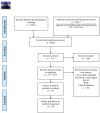Concurrent Disorder Management Guidelines. Systematic Review
- PMID: 32731398
- PMCID: PMC7463987
- DOI: 10.3390/jcm9082406
Concurrent Disorder Management Guidelines. Systematic Review
Abstract
Concurrent disorder refers to a diverse set of combinations of substance use disorders and mental disorders simultaneously in need of treatment. Concurrent disorders are underdiagnosed, undertreated, and more complex to manage, practicing the best recommendations can support better outcomes. The purpose of this work is to systematically assess the quality of the current concurrent disorders' clinical recommendation management guidelines. Literature searches were performed by two independent authors in electronic databases, web, and gray literature. The inclusion criteria were English language clinical management guidelines for adult concurrent disorders between 2000 and 2020. The initial search resulted in 8841 hits. A total of 24 guidelines were identified and assessed with the standardized guidelines assessment tool: AGREE II (Appraisal of Guidelines for Research and Evaluation). Most guidelines had acceptable standards, however, only the NICE guidelines had all detailed information on all AGREE II Domains. Guidelines generally supported combinations of treatments for individual disorders with a very small evidence base for concurrent disorders, and they provided little recommendation for further structuring of the field, such as level of complexity or staging, or evaluating different models of treatment integration.
Keywords: addiction comorbidity; co-occurring disorder; coexisting mental illness; comorbid addiction; comorbid illicit use; comorbid mental illness; comorbid substance abuse; concurrent disorder; dual diagnosis; dual pathology.
Conflict of interest statement
All authors declare no conflicts of interest.
References
-
- Torrens M., Mestre-Pintó J.-I., Domingo-Salvany A. Comorbidity of Substance Use and Mental Disorders in Europe. The European Centre for Drugs and Drug Addiction; Lisabon, Portugal: 2015.
-
- Skinner W.W.J., O’Grady P.O.C., Bartha C., Parker C. Concurrent Substance Use and Mental Health Disorders. An Information Guide. Centre for Addiction and Mental Health; Toronto, ON, Canada: 2010.
-
- Co-Center for Excellence (COCE) Definitions and Terms Relating to Co-Occurring Disorders. Co-Occurring Center for Excellence (COCE); Rockville, MD, USA: Substance Abuse and Mental Health Services Administration (SAMHSA); Rockville, MD, USA: 2007. Overview Paper 1.
-
- Dual Diagnoses Overview Series. [(accessed on 20 March 2020)];2017 Available online: http://www.dualdiagnosis.org.au/home/images/documents/1._Terminology.pdf.
Publication types
LinkOut - more resources
Full Text Sources


